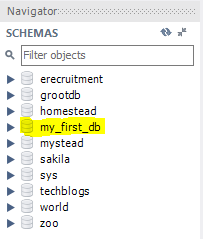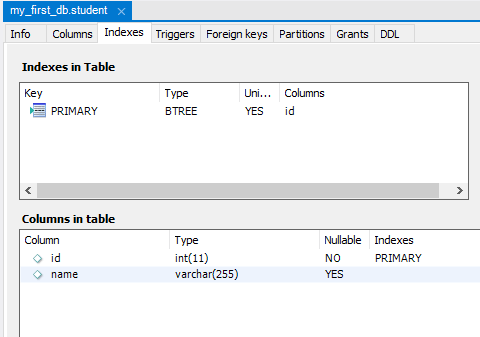python








Python과 MySQL 연결을 사용하려면 SQL에 대한 지식이 있어야 합니다.
자세히 알아보기 전에 이해합시다
MySQL은 오픈 소스 데이터베이스이며 최고의 RDBMS(관계형 데이터베이스 관리 시스템) 유형 중 하나입니다. MySQLdb의 공동 설립자는 Michael Widenius의 이름이며 MySQL 이름은 Michael의 딸에서 따온 것입니다.
이 튜토리얼에서 배우게 될 것입니다
공식 사이트에서 Linux/Unix용 RPM 패키지 다운로드:https://www.mysql.com/downloads/
터미널에서 다음 명령을 사용하십시오.
rpm -i <Package_name>
Example rpm -i MySQL-5.0.9.0.i386.rpm
Linux 체크인
mysql --version
공식 사이트에서 MySQL 데이터베이스 exe를 다운로드하고 Windows에서 일반적인 소프트웨어 설치와 같이 설치합니다. 단계별 가이드는 이 자습서를 참조하십시오.
MySQL을 Python과 연결하는 방법은 다음과 같습니다.
Python 2.7 이하의 경우 다음과 같이 pip를 사용하여 설치합니다.
pip install mysql-connector
Python 3 이상 버전의 경우 다음과 같이 pip3을 사용하여 설치합니다.
pip3 install mysql-connector
여기에서 Python에서 MySQL 데이터베이스 연결을 테스트하기 위해 사전 설치된 MySQL 커넥터를 사용하고 자격 증명을 connect()에 전달합니다. 아래 Python MySQL 커넥터 예제와 같이 호스트, 사용자 이름 및 비밀번호와 같은 기능.
Python으로 MySQL에 액세스하는 구문:
import mysql.connector
db_connection = mysql.connector.connect(
host="hostname",
user="username",
passwd="password"
) 예 :
import mysql.connector db_connection = mysql.connector.connect( host="localhost", user="root", passwd="root" ) print(db_connection)
출력 :
<mysql.connector.connection.MySQLConnection object at 0x000002338A4C6B00>
여기 출력은 성공적으로 생성된 연결을 보여줍니다.
SQL에서 새 데이터베이스를 만드는 구문은
CREATE DATABASE "database_name"
이제 Python에서 데이터베이스 프로그래밍을 사용하여 데이터베이스를 생성합니다.
import mysql.connector
db_connection = mysql.connector.connect(
host= "localhost",
user= "root",
passwd= "root"
)
# creating database_cursor to perform SQL operation
db_cursor = db_connection.cursor()
# executing cursor with execute method and pass SQL query
db_cursor.execute("CREATE DATABASE my_first_db")
# get list of all databases
db_cursor.execute("SHOW DATABASES")
#print all databases
for db in db_cursor:
print(db) 출력 :

위 이미지는 my_first_db를 보여줍니다. 데이터베이스가 생성되었습니다
아래 MySQL 커넥터 Python 예제와 같이 두 개의 열이 있는 간단한 "student" 테이블을 만들어 보겠습니다.
SQL 구문 :
CREATE TABLE student (id INT, name VARCHAR(255))
예:
import mysql.connector
db_connection = mysql.connector.connect(
host="localhost",
user="root",
passwd="root",
database="my_first_db"
)
db_cursor = db_connection.cursor()
#Here creating database table as student'
db_cursor.execute("CREATE TABLE student (id INT, name VARCHAR(255))")
#Get database table'
db_cursor.execute("SHOW TABLES")
for table in db_cursor:
print(table) 출력 :
('student',) 직원을 만들어 보겠습니다. 세 개의 다른 열이 있는 테이블. id에 기본 키를 추가합니다. 데이터베이스 연결이 있는 아래 Python 프로젝트에 표시된 대로 AUTO_INCREMENT 제약 조건이 있는 열입니다.
SQL 구문 :
CREATE TABLE employee(id INT AUTO_INCREMENT PRIMARY KEY, name VARCHAR(255), salary INT(6))
예 :
import mysql.connector
db_connection = mysql.connector.connect(
host="localhost",
user="root",
passwd="root",
database="my_first_db"
)
db_cursor = db_connection.cursor()
#Here creating database table as employee with primary key
db_cursor.execute("CREATE TABLE employee(id INT AUTO_INCREMENT PRIMARY KEY, name VARCHAR(255), salary INT(6))")
#Get database table
db_cursor.execute("SHOW TABLES")
for table in db_cursor:
print(table) 출력 :
('employee',) ('student',) Alter 명령은 SQL에서 테이블 구조를 수정하는 데 사용됩니다. 여기에서 학생 을 변경합니다. 테이블을 만들고 id에 기본 키를 추가합니다. 아래 Python MySQL 커넥터 프로젝트와 같은 필드입니다.
SQL 구문 :
ALTER TABLE student MODIFY id INT PRIMARY KEY
예 :
import mysql.connector
db_connection = mysql.connector.connect(
host="localhost",
user="root",
passwd="root",
database="my_first_db"
)
db_cursor = db_connection.cursor()
#Here we modify existing column id
db_cursor.execute("ALTER TABLE student MODIFY id INT PRIMARY KEY") 출력 :
여기 아래에서 id 를 볼 수 있습니다. 열이 수정되었습니다.

이미 생성한 MySQL Database 테이블에 삽입 작업을 수행해 보겠습니다. STUDENT 테이블과 EMPLOYEE 테이블에 데이터를 삽입합니다.
SQL 구문 :
INSERT INTO student (id, name) VALUES (01, "John") INSERT INTO employee (id, name, salary) VALUES(01, "John", 10000)
예 :
import mysql.connector db_connection = mysql.connector.connect( host="localhost", user="root", passwd="root", database="my_first_db" ) db_cursor = db_connection.cursor() student_sql_query = "INSERT INTO student(id,name) VALUES(01, 'John')" employee_sql_query = " INSERT INTO employee (id, name, salary) VALUES (01, 'John', 10000)" #Execute cursor and pass query as well as student data db_cursor.execute(student_sql_query) #Execute cursor and pass query of employee and data of employee db_cursor.execute(employee_sql_query) db_connection.commit() print(db_cursor.rowcount, "Record Inserted")
출력 :
2 Record Inserted
python
Pillow Python Imaging Library는 이미지 처리에 이상적입니다. 일반적으로 보관 및 일괄 처리 응용 프로그램에 사용됩니다. 물론, 생각할 수 있는 다른 용도로 자유롭게 사용할 수 있습니다. 라이브러리를 사용하여 다음을 수행할 수 있습니다. 썸네일 만들기 파일 형식 간 변환, 이미지 인쇄 Fet 히스토그램(자동 대비 향상에 이상적) 이미지 회전 흐림 효과와 같은 필터 적용 목차 이미지 처리 패키지 설치 이미지 처리 중 이미지 표시 추가 정보 이미지 처리 패키지 설치 Pillow를 설치하려면 원래 Pyth
Python 생태계에서 생각할 수 있는 거의 모든 것을 위한 패키지가 있으며, 모두 간단한 pip 명령으로 설치할 수 있습니다. 따라서 Python에도 이모티콘을 사용할 수 있는 패키지가 있다는 사실에 놀라지 마세요. 다음을 사용하여 이모티콘 패키지를 설치할 수 있습니다. $ pip3 install emoji 이 패키지를 사용하면 유니코드 이모티콘을 문자열 버전으로 또는 그 반대로 변환할 수 있습니다. import emoji result = emoji.emojize(Python is :thumbs_up:) print(result